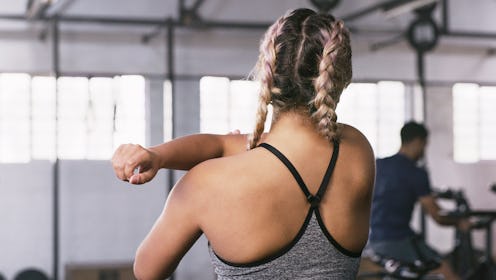Fitness
How To Warm Up Before Lifting Weights
Don't go straight into those bench presses.

If you’re short on time, it may be tempting to waltz on over to a barbell and pump out a few bench press reps. But, just like with running and other forms of exercise, trainers recommend taking a few extra minutes to warm your body up before lifting, especially if you want to make the most of your workout.
It’s important to know how to warm up before weight lifting for a number of reasons. “When we warm up, the higher body temperature actually allows the body to move things — like oxygen — faster and easier,” says Life Time personal trainer Brooke Van Paris. “This is because as the blood warms, the vessels dilate causing a chain reaction of increased heart rate, increased output, increased oxygen consumption, and therefore increased blood flow to the muscles being worked.”
A warm-up not only literally “warms” your body up so you can lift, but it also helps prevent injury. “Think about a rubber band that’s been lying around for a few years,” Van Paris tells Bustle. “When you go to pull on it, it snaps. Same with our muscles. If they aren't warmed up properly before intense exercise or heavy loading, it causes a lot of stress on the body and can result in injury.” To learn how to properly prep your muscles for your weight lifting workout, keep scrolling for what trainers want you to know.
How To Warm Up Before Weight Lifting
Van Paris recommends starting off with three to five minutes of aerobic activity. It not only increases your reaction time, but it also ups your body/brain connection for mental readiness, she says, and helps to increase the amount of synovial fluid in your joints so that they stay protected (as opposed to not primed for movement) — all good things when you’re about to pump some iron.
According to Sharon Gam, Ph.D., CSCS, ACE-HC, a personal trainer and founder of Sharon Gam Fitness, you should start your lifting workout with a quick jog. You could also do jumping jacks, burpees, or any other cardio exercise that’ll get your blood pumping.
After an aerobic warm-up, it’s a good idea to add in a quick stretch, which further preps your body for lifting. According to Austin Martinez, MS, CSCS, ATC, a certified strength and conditioning specialist and director of education at StretchLab, stretching increases your flexibility and range of motion, and also decreases your risk of post-workout soreness.
He recommends dynamic stretching in particular, which is the kind of stretching where you move fluidly through each posture instead of remaining static or still in the pose (aka static stretching, which is better for after your workout). “Stretching is especially important because lifting weights puts so much stress and pressure on your muscles,” Martinez says. “All in all, a warm-up will make for a more effective lift.”
Warm-Up Routine To Try Before Lifting
After doing your mini-cardio warm-up, try these exercises before lifting.
1. Arm Circles
- Make small circles with your arms fully straightened out at your sides.
- Slowly increase the size of circles.
- Do both arms forwards then backwards.
2. Torso Rotations
- Stand with your feet shoulder-width apart, toes facing forwards.
- Gently turn your upper body to the right until shoulders are perpendicular to your feet.
- Return to start position.
- Repeat on the left side.
3. Leg Swings
- Stand on one leg.
- Swing the other leg forward, as if you’re trying to kick something at waist height.
- Let leg fall and swing backwards.
- Repeat, then switch legs.
4. Dynamic Stretches
Move through some stretches that are specific to the muscles you’re about to work while lifting.
- To stretch your hamstrings, Martinez recommends moving one leg slightly forward, toe pointing up. Bend your other knee and reach down towards your foot. Repeat 10 times on each side.
- To open your chest, Gam recommends holding onto a wall or doorway with both hands and stepping through then back again, so you feel your chest muscles lengthen.
- You could also do shoulder rotations by holding onto a light resistance band and lifting arms up overhead.
5. Warm-Up Sets
Before you start lifting weights, Gam suggests moving through a few practice lifting rounds. By doing this, it’ll show your brain and body what they’re about to do and gets your nervous system firing, she explains. Move through a couple of easy warm-up sets using a very light weight for the job, says Gram.
In total, your warm-up should last 10 to 20 minutes. Once you feel ready, go ahead and slay that lifting sesh.
Studies referenced:
Beedle, B. (2007). A comparison of two warm-ups on joint range of motion. J Strength Cond Res. https://pubmed.ncbi.nlm.nih.gov/17685684/
Behm, D.G., Chaouachi, A. A review of the acute effects of static and dynamic stretching on performance. Eur J Appl Physiol, 111, 2633–2651 (2011). https://doi.org/10.1007/s00421-011-1879-2.
Fradkin, A.J. (2006). Does warming up prevent injury in sport? The evidence from randomised controlled trials. J Sci Med Sport. https://pubmed.ncbi.nlm.nih.gov/16679062/
Park, H. (2018). The effect of warm-ups with stretching on the isokinetic moments of collegiate men. J Exerc Rehabil. https://www.ncbi.nlm.nih.gov/pmc/articles/PMC5833972/
Perrier, Erica T; Pavol, Michael J; Hoffman, Mark A The Acute Effects of a Warm-Up Including Static or Dynamic Stretching on Countermovement Jump Height, Reaction Time, and Flexibility, Journal of Strength and Conditioning Research: July 2011 - Volume 25 - Issue 7 - p 1925-1931 doi: 10.1519/JSC.0b013e3181e73959.
Sources:
Brooke Van Paris, personal trainer at Life Time gyms
Austin Martinez, MS, CSCS, ATC, certified strength and conditioning specialist and director of education at StretchLab
Sharon Gam, Ph.D., CSCS, ACE-HC, personal trainer and founder of Sharon Gam Fitness.
This article was originally published on